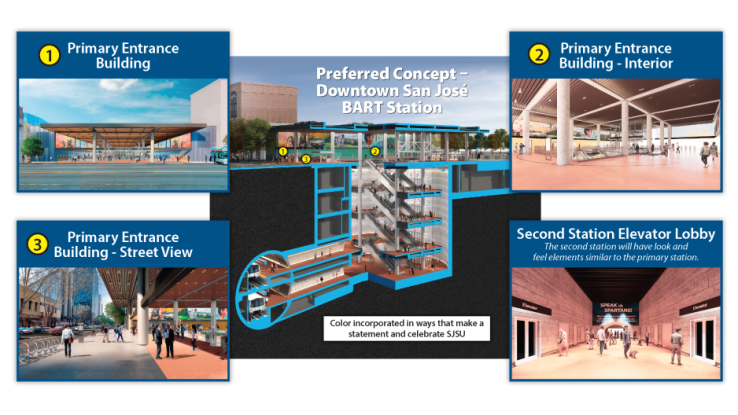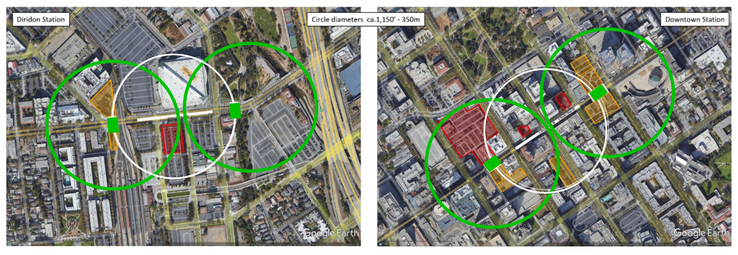SPUR is a long-time supporter of BART Phase II, which will bring BART service into downtown San José. It is a critical project to the region, and SPUR is invested in its success.
The project gets many things right. Fundamentally, the arrival of BART in San José is intended to provide a faster, more predictable, more sustainable and more affordable travel option to people living and working in the South Bay — and it will. In addition, the project has two other goals: 1. to grow San Jose’s economic prosperity by making it possible for a lot more people to live and work downtown without needing to use a car for every trip, and 2. to make transit the first and best choice for many types of trips that are currently taken by car. In these areas we think the project can do better. For the many billions of dollars in public money that will be invested in this project, we think the project must do better.
We cannot ignore that BART Phase II bears the heavy weight of expectations. Santa Clara County residents have invested in this project for decades. Many question the essential role of transit in our changing world and doubt government’s ability to do big things. In SPUR’s view, the importance of getting this project right transcends the project itself. If it is successful, it can help spur a new sense of confidence and optimism in transit and in government institutions, which the region critically needs. Years from now, we don’t want this project to be known for how expensive it was, but for how deeply and positively it transformed the way people move, the way San José has grown and the way people think about their government.
VTA recently convened a collaborative four-party task force that includes VTA, the City of San José, BART and SPUR to work together to explore and evaluate opportunities to improve passenger experience and station access while retaining the current plan to use single-bore tunnel construction methods. We are optimistic that this process will result in a better project. The goal is to explore design changes that could make BART easier and more attractive to use, more seamlessly connect it to other modes, and make sure it maximizes opportunities to grow downtown while integrating thoughtfully with its urban context. This includes rethinking the number and location of station entrances — changes that can be incorporated into current and future procurements for tunnels and stations.
This article shares our goals for BART Phase II, how we hope these goals can be translated into the project design and our desired outcomes from the collaborative innovations process.
The Question of Tunneling
To date, there has been a lot of debate about the construction technology and whether to dig a single-bore or double-bore tunnel. To be clear, SPUR is not motivated by a preference for a particular tunneling methodology. Rather, our intent is to maximize the project’s benefits to ensure that the project is delivered cost-effectively and meets its goals.
Some of the more important factors for passenger experience are the number and location and layout of stations, and the location and layout of vertical circulation elements (e.g., escalators, stairs and elevators) that bring people from the street to the platform. These factors are shaped not primarily by the decision to construct a single-bore tunnel but by the decisions to avoid cut-and-cover stations and to locate the stations off-street and inside of the tunnel shaft (as shown in the center image of Figure 1).
Figure 1. Downtown Entrances and Underground Station Elements

Image by VTA, https://www.vta.org/bart/station-aesthetics#accordion-more-about-preferred-concepts-for-the-downtown-san-jos--bart-station
What Success Looks Like
We focus on stations because they are not simply places to buy tickets and board trains. They are the primary touchpoint with BART and key gateways to the city. People spend a significant part of their trips getting to and from stations, or waiting in stations. Stations can catalyze urban growth and define communities.
- Station entrances. The project will be successful if it is designed for the future San José that we as a community are collectively trying to build — one with high-density housing and jobs in an urban, walkable format, with good connections to the region’s other urban centers. The project can maximize its benefits by bringing as many people within walking distance to BART as possible, providing more opportunities for high-density development and more value capture potential. It can do that by providing more and better entrances for each station. At the downtown station, it means adding an entrance on the south side of Santa Clara Street. Ideally this entrance would be located further east to open up greater access to the eastern side of downtown. This would create better access to City Hall and San José State University, as well as to many underutilized sites that could host transit-oriented development.
Ideally, these station entrances would be located at the ends of the platforms and both the sides of the street (in this case, the north and south sides of Santa Clara Street). Most other BART stations are designed this way, and with good reason: It is the best solution for mass transit systems.
Figure 2. Accessibility Benefits of Multiple Station Entrances

Image by SPUR in collaboration with Andreas Heym Planning & Design and DeutscheBahn
- Access, circulation and resilience. The project will be successful if stations and platforms are easy, intuitive and comfortable for passengers to access. People need to be able to easily enter and leave the platform and the station under normal operating conditions, crowding conditions (such as during a Sharks game or concert at the SAP Arena), or conditions when one of the exits needs to be out of commission for maintenance or due to a hazardous event. SPUR will encourage VTA to explore ideas such as multiple station and platform entrances at each station, including on both sides of Santa Clara Street.
- Convenience and ease of use. The project will be successful if it enables passengers to get to the street from the platform — and vice versa — safely and as part of their natural path of travel. It should also be designed to make the single bore tunnel’s platform depths more manageable. SPUR will work with VTA to explore designs that bring people between the street and platform without having to change directions multiple times. We will also encourage the city and VTA to work together to make Santa Clara Street safer for people walking and biking and to reduce traffic volumes.
- Construction methods. The project will be successful if seeks to minimize and proactively address, but not avoid, surface disruption if it is essential for achieving the project’s goals and maximizing project benefits. The concerns of downtown businesses regarding the impacts of construction are real and valid. The surface impacts could also be temporary and targeted if planned well and mitigated carefully. SPUR will encourage VTA to be careful to minimize unnecessary disruption and to mitigate necessary disruption with a robust business interruption plan designed in partnership with the business community. As case studies conducted by the Eno Center on Transportation have shown, “by trying to pre-empt the short-term cost problem, project sponsors instead create separate long-term problems where transit is underutilized.”
- Multimodal integration. The project will be successful if treats co-located transportation projects as one project and one place. This is especially true for Diridon Station, where at least 6 major regional rail and transit operators will converge. BART will bring the most people to Diridon, so having a quick and easy connection between BART and other modes is essential. This means committing to a shared vision for success — the Diridon Integrated Station Concept — and fully understanding the relationships and interdependencies between each of the projects at the station. The success of BART is intertwined with the success of Diridon as a whole. SPUR will encourage integrated planning and design, even if BART is further along than the other planned projects.
Desired Outcomes for the Collaborative Innovations Process
As mentioned above, VTA has convened a collaborative innovations process and invited SPUR to participate. Our hopes for this process are twofold. First, we hope that the collaborative innovations period will result in a project that includes the following design elements:
- More station entrances to shorten access times, make transit more time-competitive and grow ridership potential, including station entrances on both sides of Santa Clara Street. Ideally, these will be located at the ends of the platforms.
- Better potential to maximize and integrate with transit-oriented development, including a downtown station entrance further east and a headhouse at Diridon whose shape has edges that integrate well with urban development.
- Stations that offer direct, intuitive pathways from the street to the platform for better boarding efficiency and circulation.
- The potential for a short and intuitive connection to other transit modes at Diridon Station and buses on Santa Clara Street.
- An underground mezzanine that allows for better circulation and access from both the north and south sides of Santa Clara Street, and thoughtful management of the safety of people walking and biking at the street level.
Further, while we fully recognize the importance of implementation considerations such as cost, constructability, disruption, schedule and environmental approvals, we hope these will not be the overriding constraints. The cumulative benefits of any one of these proposals may justify a change to the project. It’s important to deliver the best possible project, not just deliver the project.
Additionally, we hope that VTA will find ways to bring down project costs without compromising the above goals. We care about both costs and cost effectiveness. Whether the project costs $6 billion or $9 billion, it can and should be a great project, but we hope it won't cost $9 billion.
Finally, we request that the assessment of tradeoffs take place openly and transparently, making it clear why certain options are either not feasible or not desirable. An over-emphasis on constraints is precisely the reason so many have raised concerns about the project.
Conclusion
Our hope is that BART Phase II will be designed for the next 100 years and will keep the customer front of mind in all design decisions. Santa Clara County residents can get more benefit from their investments if BART is convenient and welcoming to riders and makes it easy and quick to get to and from many different places in downtown San José, so that more people choose transit over driving. Now is the moment to evolve the current project design in order to maximize the project’s benefits for riders, the city and the climate. There is only one chance to build this project; the decisions made now will last for the next century.
See more information and renderings of the downtown station
See more information and renderings of Diridon Station
Many thanks to Andreas Heym of Andreas Heym Planning + Design and Agustin Arizti of DB E.C.O North America Inc. for their thoughtful perspectives and collaboration with SPUR.
